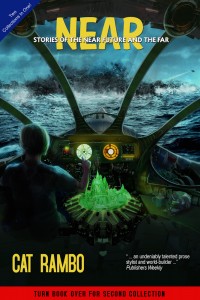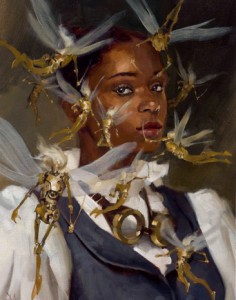
Description captures so much nuance, and the structure of the sentence can prove integral to its effect, as frequently happens in Dunnett's writing.
In this chapter Lymond and Oonagh are escaping the Turkish camp, and it’s just marvelous.
At the edge of the still, dark pool that was the sea, at the brimming edge of freedom where no boat was to be seen, she spoke the first words of the few they were to exchange. ‘I cannot swim. You know it?”
The sea is the still dark pool, the brimming edge of freedom and we know that it’s still perilous and questionable because they can’t even see the boat. It’s a passage where words are scarce and breath is conserved, and Dunnett deftly raises the stakes here with that six word exchange.
In the dark she saw the flash of his smile. ‘Trust me.’ And he drew her with a strong hand until the green phosphorescence beaded her ankles, and deeper, and deeper, until the thick milk-warm water, almost unfelt, was up to her waist. She heard him swear feelingly to himself as the salt water searched out, discovered his burns. Then with a rustle she saw his pale head sink back into the quiet sea and at the same moment she was gripped and drawn after him, her face to the stars, drawn through the tides with the sea lapping like her lost hair at her cheeks, the drive of his body beneath her pulling them both from the shore. They were launched on the long journey towards the slim shape, black against glossy black, which was the brigantine, with Thompson on board.
Right off the bat, the first moment of the paragraph, the terse tense nature of the dialogue is maintained, along with a single detail reminding us of the lack of lighting. And because it’s Lymond, brilliant ephemeral Lymond, that detail backs up the dazzle of his character with its verb masquerading as a noun: flash. The moment where he draws her into the water, first to the lovely image of the phosphorescence around her ankles, then and deeper, and deeper, as though each comma was a wave, is one of those that bludgeons me with despair whenever I read Dunnett, because I don’t think I’ll ever come close to the precision and brilliant construction of that sentence, and she does it line after line after line for six fricking books, plus the eight book Niccolo series and the MacBeth one. HOLY COW. And then she delivers the final stroke with the temperature of the silky water combined with the information that now she’s up to her waist. We’re reminded that Lymond is not in the best physical shape because Dunnett never resists a chance to ratchet up the tension.
After that a long sentence conveys the sense of the journey, starting with the sound and visual of his pale head. Something about the way the sentence is constructed mimics the physical blocking of the scene, with Oonagh being drawn over and through the water with the drive of his body submerged beneath, pulling them both forward. Followed by more journey, and even more sense of the lighting, with the ship black against glossy black.
She never knew how long a swim that was, for she had one task: to make his work possible. Her body limp, her limbs brushing the surface of the sea, she took air at the top of his thrust; learned after the first gagging mistake to close every channel to the sudden dip, the molesting wave that slapped suddenly over one cheek. The hard grip under her armpits never altered, nor did Lymond’s own breathing for a long time vary at all.
That paragraph has a lot of sexual, physical terms (her body limp, her limbs brushing the surface of the sea, she took air at the top of his thrust) that turn violent (learned after the first gagging mistake to close every channel to the sudden dip, the molesting wave that slapped suddenly over her cheek), which echoes Oonagh’s experiences in the book, having been beaten many times by her former lover Cormac MacCarthy. But interestingly, the next sentence shows us that Lymond is steady where the violence is sporadic; he is drawing her forward through it. I’ve noticed Dunnett repeating figures like this over and over before — in Queens’ Play, it’s eyes, for example, so I’ll be curious to see whether this keeps getting repeated — or I may go back to earlier chapters to look at their interactions again.
I urge my writing students to copy out passages like this, to test them sentence by sentence, looking to see how the effects are created. Sometimes it’s just an exercise in angst, when you’re working with a writer that’s much better than you are, but I can’t help but think you always learn something from the practice.





